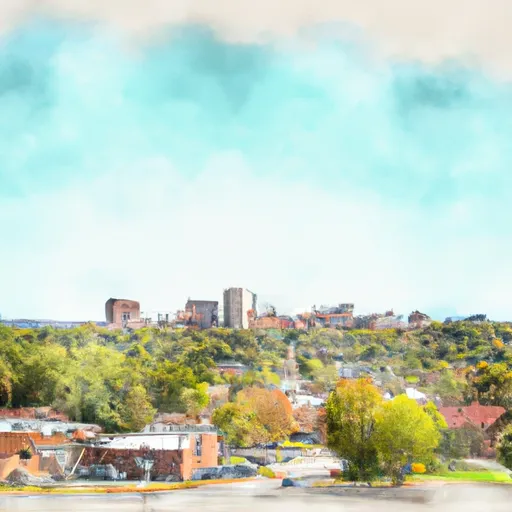-
 Snoflo Premium
Snoflo Premium
Get unlimited access to all our content
With no Ad interruptions! - Start Your Free Trial Login with existing account
Springdale
Eden Index
Climate
8.3
•
Recreation
4.8
•
Community
3.3
•
Safeguard
5.8/10

Located in the northwest region of Arkansas, Springdale is a vibrant city known for its diverse climate, lush natural surroundings, and ample outdoor recreation opportunities. The city experiences a humid subtropical climate with hot summers and mild winters. Average temperatures range from 30°F (-1°C) in winter to 90°F (32°C) in summer. Springdale receives around 46 inches of rainfall annually, with May being the wettest month.
Springdale boasts several hydrology constituents, including the beautiful Beaver Lake, which offers opportunities for fishing, boating, and swimming. The city is also home to numerous smaller lakes and rivers, providing further options for water-based activities.
Outdoor enthusiasts will find plenty to do in Springdale. The city is surrounded by the stunning Ozark Mountains, offering opportunities for hiking, camping, and wildlife viewing. The nearby Ozark National Forest provides additional recreational activities such as mountain biking, rock climbing, and hunting. Springdale is also home to a variety of parks, trails, and golf courses, ensuring residents and visitors have plenty of options for outdoor enjoyment.
In summary, Springdale, Arkansas, offers a range of outdoor recreational opportunities thanks to its pleasant climate, water resources, and scenic surroundings, making it a desirable destination for nature lovers and outdoor enthusiasts alike.
What is the Eden Index?
The Snoflo Eden Index serves as a comprehensive rating system for regions, evaluating their desirability through a holistic assessment of climate health, outdoor recreation opportunities, and natural disaster risk, acknowledging the profound impact of these factors on livability and well-being.
Climate Health Indicator (CHI): 8.3
Springdale receives approximately
1150mm of rain per year,
with humidity levels near 81%
and air temperatures averaging around
14°C.
Springdale has a plant hardyness factor of
6, meaning
plants and agriculture in this region thrive during a short period during spring and early summer. Most
plants will die off during the colder winter months.
By considering the ideal temperature range, reliable water supplies, clean air, and stable seasonal rain or snowpacks, the Climate Health Indicator (CHI) underscores the significance of a healthy climate as the foundation for quality living.
A healthy climate is paramount for ensuring a high quality of life and livability in a region, fostering both physical well-being and environmental harmony. This can be characterized by ideal temperatures, reliable access to water supplies, clean air, and consistent seasonal rain or snowpacks.
Weather Forecast
Streamflow Conditions
Robert S. Kerr Reservoir
Area Rivers
Robert S. Kerr Reservoir
Snowpack Depths
Robert S. Kerr Reservoir
Reservoir Storage Capacity
Robert S. Kerr Reservoir
Groundwater Levels
Recreational Opportunity Index (ROI): 4.8
The Recreational Opportunity Index (ROI) recognizes the value of outdoor recreational options, such as parks, hiking trails, camping sites, and fishing spots, while acknowledging that climate plays a pivotal role in ensuring the comfort and consistency of these experiences.
Access to outdoor recreational opportunities, encompassing activities such as parks, hiking, camping, and fishing, is crucial for overall well-being, and the climate plays a pivotal role in enabling and enhancing these experiences, ensuring that individuals can engage in nature-based activities comfortably and consistently.
Camping Areas
| Campground | Campsites | Reservations | Toilets | Showers | Elevation |
|---|---|---|---|---|---|
| Kelly Creek Park - Lake Wright Patman | 80 | 252 ft | |||
| Cass County Park | 46 | 244 ft | |||
| Piney Point - Wright Patman Lake | 70 | 298 ft | |||
| Intake Hill Park- Wright Patman Lake | None | 251 ft | |||
| Malden Lake - Wright Pattman Lake | 39 | 259 ft | |||
| Rocky Point - Wright Patman Lake | 125 | 259 ft | |||
| Atlanta State Park | 60 | 286 ft | |||
| Herron Creek - Wright Patman Reservoir | 100 | 267 ft | |||
| Clear Springs - Wright Patman Lake | 100 | 259 ft | |||
| Jackson Creek Park - Lake Texarkana | None | 327 ft |
Nearby Ski Areas
Catastrophe Safeguard Index (CSI):
The Catastrophe Safeguard Index (CSI) recognizes that natural disaster risk, encompassing floods, fires, hurricanes, and tornadoes, can drastically affect safety and the overall appeal of an area.
The level of natural disaster risk in a region significantly affects safety and the overall livability, with climate change amplifying these risks by potentially increasing the frequency and intensity of events like floods, fires, hurricanes, and tornadoes, thereby posing substantial challenges to community resilience and well-being.
Community Resilience Indicator (CRI): 3.3
The Community Resilience Indicator (CRI) recognizes that education, healthcare, and socioeconomics are crucial to the well-being of a region. The CRI acknowledges the profound impact of these elements on residents' overall quality of life. By evaluating educational resources, healthcare accessibility, and economic inclusivity, the index captures the essential aspects that contribute to a thriving community, fostering resident satisfaction, equity, and social cohesion.

